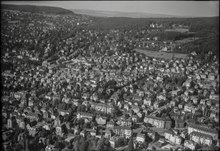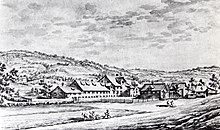Hottingen (City of Zurich)
|
Hottingen district of Zurich |
|
|---|---|
| Coordinates | 684 730 / 246 970 |
| height | 444 m |
| surface | 5.05 km² |
| Residents | 11,172 (2017) |
| Population density | 2212 inhabitants / km² |
| BFS no. | 261-072 |
| Post Code | 8032 |
| Urban district | District 7 since 1893/1913 |
Hottingen is a district of the city of Zurich . The formerly independent municipality Hottingen was incorporated in 1893 and is today together with Fluntern , Hirslanden and Witikon the Kreis 7 .

coat of arms
- In red a stalked, four-leaf green clover
history

Hottingen is first mentioned in documents as Hottinga in 946 . At the end of the Middle Ages the settlement consisted of a good two dozen households. Later, two settlement centers were formed around today's Kreuzplatz and today's Hottingerplatz. The slopes of the Adlisberg were almost entirely used by vines . In the 18th century, small craftsmen and home workers in the textile industry lived alongside farmers .
With the development of the nearby city of Zurich, a lot of construction activity began in the 19th century. 1902–1905 the Evangelical-Reformed Kreuzkirche was built in the style of Classicism and Art Nouveau , as a counterpart to the church opposite Enge . 1906–1908 followed the Roman Catholic Church of St. Anton , which was built as a neo-Romanesque church with Art Nouveau elements and was the first public commission of the later ETH professor Karl Moser in Zurich.
religion
In Hottingen there are currently eight Christian communities and groups, which are divided into seven places of worship:
- Reformed parish of Zurich of the Evangelical Reformed Church of the Canton of Zurich , Kreuzkirche location ; Church built 1902–1905 by the architects Otto Pflegehard and Max Haefeli . The Zurich-Hottingen parish, which existed until the end of 2018, stretched from the Kunsthaus up to the Grand Hotel Dolder to the edge of the forest; it had over 3000 members.
- Roman Catholic Church in Switzerland - Parish Sankt Anton ; Church built 1906–1908 by the architect Karl Moser
- Mission Catholique de langue française - Catholic mission for French speakers from the greater Zurich region; Church Sainte Famille built 1964-1966 by the architect Walter Pfammatter and Walter Rieger
- New Apostolic Church - Zurich-Hottingen congregation; Church built 1977–1979 by the architects Hans Weideli and Ernst Kuster
- Evangelical Free Church Congregation St. Chrischona and youth group “Destiny Church” in the Bethel Chapel
- Baptist Congregation - Salemskapelle
- Evangelical Anabaptist Congregation - Evangelical Congregation House Hottingen
- First Church of Christ Scientists - Church at Kreuzplatz, built 1937–1938 by the architects Hans Hofmann and Adolf Kellermüller
Zurich's Hare Krishna temple is located on Bergstrasse at Wolfbachtobel .
Education and culture
Six public schools are located in Hottingen. The quarter belongs to the urban school district of Zürichberg ; the primary schools “Bungertwies” - organized as a day school - and Ilgen are located in the quarter itself . The “Bungertwies” has its own school swimming pool; the school houses the kindergarten level, the lower level (1st – 3rd grade) and the intermediate level (4th – 6th grade). The «Ilgen» accommodates the kindergarten and lower grades in Ilgen A and the intermediate level in Ilgen B.
The upper level (7th – 9th school year) is attended in the neighboring quarters, the Zurichberg school district comprises the three high school buildings Hirschengraben, Hirslanden-Hofacker and Riesbach-Münchhalde, as well as the Neumünster art and sports school.
Of the grammar schools organized at the cantonal level, the Rämibühl canton school and the Hottingen canton school are located in Hottingen . KS Hottingen is a high school with an economic and legal profile and a computer science middle school .
Reading circle Hottingen
The Hottingen reading circle was founded on November 4, 1882 by Hottinger gymnastics club colleagues Wilfried Treichler and Hans Bodmer in the inn at Sonnegg. He wanted to make "instructive entertainment", "knowledge of daily literature" and "study of political, social, scientific and artistic life of the present" accessible to "large sections of the population free of charge". The legendary evenings for literature and art began in 1886. Hugo von Hofmannsthal , Rainer Maria Rilke , Gerhart Hauptmann , Hermann Hesse , Rudolf Alexander Schröder , Karl Kraus , Ernst Zahn and Thomas Mann read among others .
For around 50 years the Hottingen reading circle, organized as an association, was a defining element in the cultural life of the city of Zurich. At the beginning of the Second World War he was liquidated due to financial difficulties.
Personalities
- Johann Jakob Füssli (1792–1860), Protestant clergyman and Antistes from Zurich, died in Hottingen
- Carl Abegg (1860–1943), textile manufacturer; Born on October 20, 1860 in Hottingen
- Bertha von Petersenn (1862–1910), reform pedagogue; born on October 4, 1862 in Hottingen
- Sigismund Righini (1870–1937), painter and art politician
- Ernst Zuppinger (1875–1948), painter, born in Hottingen
- Fritz Baltzer (1884–1974), zoologist, developmental physiologist and geneticist; Born on March 12, 1884 in Hottingen
- Willy Fries (painter, 1881) (1881–1965), painter
- Elisabeth Luz (1888–1971), social worker, born on August 22, 1888 in Hottingen
- William Wolfensberger (1889–1918), pastor poet, born on June 17, 1889 in Hottingen
- Franz Tank (1890–1981), physicist, born on March 6, 1890 in Hottingen
- Hanny Fries (1918–2009), painter and illustrator
Attractions
- The Schauspielhaus am Heimplatz (Pfauen) is the city's most important spoken theater .
- The Protestant cruciform church , built between 1902 and 1905, with its imposing dome is a combination of different architectural styles from classicism to art nouveau. The outline of the cross lies in the middle of Hottingen's residential and school district.
- The Kulturama on Englischviertelstrasse is a museum about evolution and cultural history. It shows exhibits from palaeontology to document the evolutionary biology of humans and animals, but is also dedicated to the early advanced cultures.
- In the former studio of the artists Sigismund Righini, Willy and Hanny Fries at Klosbachstrasse 150, exhibitions have been shown regularly since 2013. The Righini-Fries Foundation preserves their artistic and written bequests.
- The Coninx Museum on Heuelstrasse houses the collection of the painter and art collector Werner Coninx (1911–1980).
- The Dolder Grand is one of the most exclusive hotels in the city of Zurich and since its extensive renovation by the architect Norman Foster has been a building complex that combines historical and modern hotel architecture.
- The Bircher Benner Clinic - the former sanatorium of the Birchermüesli inventor Maximilian Oskar Bircher-Benner - is now owned by Zurich Financial Services and serves other purposes. The buildings on Keltenstrasse and Köllikerstrasse are still preserved.
- Both the old and the new FIFA headquarters are located in Hottingen: first on the Sonnenberg, now near the zoo .
traffic

Hottingen is accessed from the city center by tram lines 3, 8 and 15 of the Zurich public transport company , and also by trolleybus line 31 . The higher-lying areas of the district can be reached with the Tangential Trolleybus route 33 and the Dolderbahn . The Kreuzplatz on the southern edge of the district is also connected to public transport by tram lines 11 and the Forchbahn (S18).
The main traffic axes are Hottingerstrasse (which begins at the Schauspielhaus and turns into Asylstrasse at Römerhofplatz) and Bergstrasse (which connects Klusplatz with the Fluntern church). Another important traffic axis - which already forms the district boundary to Riesbach - is the Kreuzbühlstrasse / Forchstrasse (connection from Stadelhofen train station to Hegibachplatz).
literature
- Sebastian Brändli u. a .: Hottingen. From the rural scattered settlement to the urban city quarter. Edited by the district association Hottingen. Zurich 2000, ISBN 3-905647-11-7 .
- Martin Illi: Hottingen. In: Historical Lexicon of Switzerland .
- Presidential Department of the City of Zurich, Statistics City of Zurich: Quartierspiegel Hottingen. Zurich 2015 ( online ).
- Marius Winzeler and Günther Hauff: The Kreuzkirche in Zurich-Hottingen. Swiss Art Guide GSK, Volume 547.Bern 1994, ISBN 3-85782-547-2 .
Web links
Individual evidence
- ^ Conrad Ulrich: The reading circle Hottingen. NZZ Libro, Zurich 1981, ISBN 978-3-03823-391-6 ; AC The Hottingen Reading Circle. (PDF; 949 kB) Neue Zürcher Zeitung , December 23, 1981, p. 29.
- ^ Righini Fries Foundation


